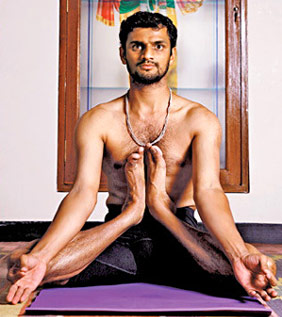 Astanga Yoga is a system of Yoga that was taught by the sage Vamana Rishi in the Yoga Korunta, which is an ancient manuscript "said to contain lists of many different groupings of asanas, as well as highly original teachings on Vinyasa, Drishti, Bandhas, Mudras and Philosophy". This text was imparted to Sri T. Krishnamacharya in the early 1900's by his Guru Rama Mohan Brahmachari, and was later passed down to Pattabhi Jois during the duration of his studies with Krishnamacharya, beginning in 1927. Since 1948, Pattabhi Jois has been teaching Ashtanga Yoga from his yoga shala, the Astanga Yoga Research Institute.
Astanga Yoga is a system of Yoga that was taught by the sage Vamana Rishi in the Yoga Korunta, which is an ancient manuscript "said to contain lists of many different groupings of asanas, as well as highly original teachings on Vinyasa, Drishti, Bandhas, Mudras and Philosophy". This text was imparted to Sri T. Krishnamacharya in the early 1900's by his Guru Rama Mohan Brahmachari, and was later passed down to Pattabhi Jois during the duration of his studies with Krishnamacharya, beginning in 1927. Since 1948, Pattabhi Jois has been teaching Ashtanga Yoga from his yoga shala, the Astanga Yoga Research Institute.Astanga Yoga literally means the "eight-limbed yoga," as outlined by the sage Patanjali in the Yoga Sutras. According to Patanjali, the path of internal purification for revealing the Universal Self consists of the following eight spiritual practices:
1.Yamas (Principles or moral code)
Yama means restraints There are five yamas viz. Ahimsa, Satya, Asteya, Brahmacharaya and Aparigraha.
Ahimsa : Ahimsa is the foundation upon which the rest of the Yamas and Niyamas are based. One must have Ahimsa in one's thoughts, speech and actions.
Satya : Truth must always co-relate with the facts as they are. Truth that causes pain or injury is not positive. Truth should be spoken in harmony with nature.
Asteya : One must not take away from another. It would deprive others from the fruits of their work or from what is rightfully theirs. Thus stealing cause injury as well.
Brahmacharya : Control of sex organs / instincts increases one's energy. From this energy one can gain miraculous powers, or more important - can gain knowledge.
Aparigraha : Non - conveotusness is the lack of desire to possess not only material objects, but persons, places, feelings and so forth. The One who has no interest or desire to possess the past, present or future, will find knowledge of these three : time states coming to him naturally.
2. Niyamas (Self-Purification and study)
Niyam means observances . There are five niayamas viz. Saucha, Santosh, Tapa, Swa - adhyay and Ishwar Pranidhan
Saucha : Physical and mental cleanliness.
Santosh : Contentment with what one has.
Tapa : By fortitude the removal of impurities and mastering of the body and the senses follow.
Swadhyaya : Through self study, communication can be established with the desired spiritual entity.
Ishwar Pranidhan : " Our intelligence is no match to the divine wisdom". Keeping this in mind always, one should surrender to the will of God with complete faith after having done one's duties very well.
For more, visit the link below: